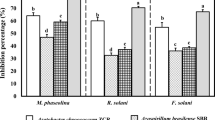Abstract
It had been shown previously that the resistance of sugarcane variety Co. 453 to root rot caused byPythium graminicolum, is associated with the presence in its rhizosphere of a high proportion of bacteria and actinomycetes capable of inhibiting the growth ofP. graminicolum, in vitro, as also of antagonistic fungi likeTrichoderma viride andPenicillium rugulosum which inhabit the rhizosphere of this variety by virtue of their ability to parasitise mycelia of certain Mucorales. Conversely, this type of microflora is absent from the rhizosphere of the susceptible variety, Co. 419.
Root interaction is known to profoundly affect the growth of plants. A study was undertaken to see if root proximity of the root rot resistant and susceptible varieties, Co. 453 and Co. 419 respectively, would affect their reaction to the disease and if so, whether the latter would be correlated with the effects on the rhizosphere microflora of the two varieties. In mixed cultivation, Co. 419 acquired a degree of resistance, but Co. 453 did not lose its resistance. There was a quantitative increase in the numbers of bacteria, actinomycetes and fungi in the rhizosphere of each of the components of the mixture as compared with uniculture in each of two soils used in the study. The proportion of antagonistic actinomycetes in the rhizosphere of Co. 453 increased, while the proportion in that of Co. 419 remained about equal to that in uniculture. Although the numbers of bacteria increased, there was little change in the proportion of antagonistic members.
In mixed culture, there were striking changes in the species of fungi occurring in the rhizosphere of each of the two varieties. Certain Mucorales likeRhizopus stolonifer andCunninghamella bertholettiae and the antagonistic fungi,Trichoderma viride andPenicillium rugulosum characteristic of the rhizosphere of Co. 453 in uniculture were found to occur in that of Co. 419 while others characteristic of Co. 419 likeFusarium moniliforme andDrechslera oryzae moved into the rhizosphere of Co. 453.
In the absence of bacteria and actinomycetes, interchange of fungal species between the rhizospheres of the varieties occurred as in their presence. No interchange of antagonistic bacteria and actinomycetes was apparent in the presence or absence of fungi, but intensification of the rhizosphere effect on bacteria and actinomycetes occurred irrespective of the presence or absence of fungi.
It was shown that Co. 419 became resistant toPythium root rot under the influence of mixed culture with Co. 453, only in the presence of the fungal component of the rhizosphere and not in the presence of the bacteria and actinomycetes alone in the absence of fungi. On the other hand, it was seen that Co. 453 owed its resistance to the fungi as well as to the bacteria and actinomycetes.
Similar content being viewed by others
References
Blair, I. D... “Behaviour of the fungusRhizoctonia solani Kuehn in the soil,”Ann. appl. Biol., 1943,30, 118–27.
Clark, F. E... “Effects of soil amendments upon the bacterial populations associated with roots of wheat,”Trans. Kans. Acad. Sci., 1939,42, 91–96.
—————.. “Soil micro-organisms and plant roots,”Advances in Agron., 1949,1, 241–88.
Davis, E. F... “The toxic principle ofJuglans nigra as identified with synthetic juglone and its toxic effects on tomato and alfalfa plants,”Amer. J. Bot., 1928,15, 620.
Isakova, A. A. and Aniskina, Z. N. “Microbiological processes in the rhizosphere and bacteriorrhiza of perennial grasses and means of regulating these,”Sovetsk. Agron., 1950,1950, 35–43.
Katznelson, H., Lochhead, A. G. and Timonin, M. I. “Soil micro-organisms and the rhizosphere,”Bot. Rev., 1948,14, 543–87.
Kerr, A... “Some interactions between plant roots and pathogenic soil fungi,”Aust. J. biol. Sci., 1956,9, 45–52.
Loehwing, W. F... “Root interactions of plants,”Bot. Rev., 1937,3, 195–239.
Sadasivan, T. S... “Some aspects of soil-borne fungal diseases in plants,”Sahni Mem. Vol. Palaeobot., 1952,1, 400–07.
Srinivasan, K. V. .. “Studies in the microflora of the rhizosphere of sugarcane with particular reference to some diseases,”Doctoral Thesis, University of Madras, 1959.
—————.. “Sugarcane root rot,”Indian J. Sugarcane Res. and Dev., 1964,8, 293–98.
----- .. “The role of the rhizosphere microflora in the resistance of sugarcane toPythium root rot,”Proc. intern. Soc. Sugarcane Technol. Taiwan, 1968,13 (accepted for publication).
Virtanen, A. I... “Die Wechselbeziehungen zwischen Leguminosen und Nichleguminosen bezuglich der Stickstofferenahrung,”Proc. 6th int. bot. Congr., 1935,2, 3–5.
Author information
Authors and Affiliations
Additional information
Communicated by Prof. C. V. Subramanian,f.a.sc.
Approved for publication by the Director, Sugarcane Breeding Institute, Coimbatore. Partly condensed from a thesis approved for the Ph.D. degree of the Madras University.
Rights and permissions
About this article
Cite this article
Srinivasan, K.V. Effect of a varietal mixture on sugarcane root rot susceptibility and on the rhizosphere microflora. Proc. Indian Acad. Sci. 68, 150–162 (1968). https://doi.org/10.1007/BF03052514
Received:
Issue Date:
DOI: https://doi.org/10.1007/BF03052514




